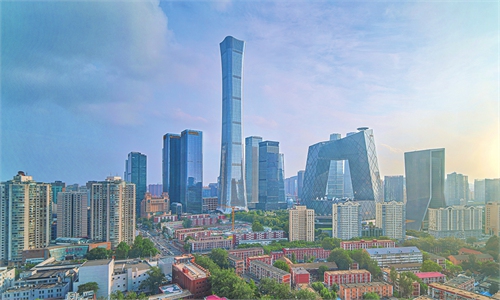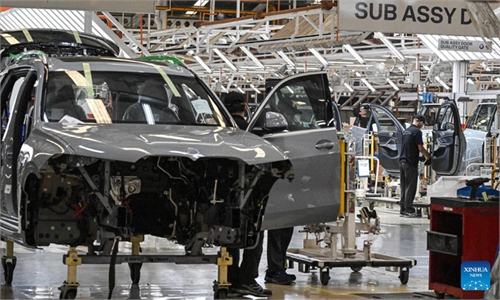
Illustration: Chen Xia/GT
China's largest cities including Beijing, Shanghai, Shenzhen and Hangzhou have recently accelerated their pace of green transformation by quickly replacing internal combustion engine vehicles with clean new-energy ones.Shanghai announced last week that the city's taxi and bus fleet, which currently emit carbon dioxide and other pollutants, will be phased out by the end of 2027. Beijing, China's capital city, has also implemented an action program to increase the number of new-energy buses, cars and trucks on the city's roads to at least two million by 2025.
According to the latest data from the China Passenger Car Association, sales of new energy vehicles (NEVs) in China surged by 36.9 percent year-on-year in July, reaching 878,000 units. When the penetration rate of NEVs outpaces combustion-engine vehicles in the world's largest auto market in such a short space of time - less than a decade - the trend becomes irreversible, signaling the decline of gasoline-fired, carbon-fuming vehicles.
This transition is driven by market forces, as the majority of NEVs manufactured in China are inexpensive, technologically-advanced, and affordable to the mass market. It is also a choice of historical importance, as our planet urges us to curb carbon emissions and address climate change.
It is China's immense and resourceful investment in the past 20 years that underscores the country's current advantages in producing high-efficiency and long-range batteries, as well as advanced autonomous-driving and in-vehicle infotainment systems. An open and transparent market that inspires full-fledged competition among battery and electric vehicle makers has led to a successful emerging industry in China.
Despite rising protectionism in the US and other Western countries, China's NEV-making technology has continued to improve and is now being introduced to a few trade-friendly markets, allowing those countries to benefit from Chinese companies' technological progress.
With this new wave of scientific and technological revolution evolving at a fast pace globally right now, the Third Plenary Session of the 20th Central Committee of the Communist Party of China, convened last month in Beijing, has mandated that China should take the initiative to improve the institutions and mechanisms for fostering new quality productive forces in line with local conditions.
By all metrics, future industries are often the emerging industries that are developed and nurtured using advanced technologies. These industries are considered strategically important due to their significant market potential once they are proven to be commercially viable. The development of emerging industries calls for sustained investment in talented researchers and innovators. Since 2000, the Chinese government has placed scientific training of the young and collegiate science and engineering education high on agenda, and the country has gradually built up a "rich depot" of skilled men and women needed by high-end manufacturing and technology innovation.
At the same time, the government has ramped up forward-looking planning and policy guidance and adopted a comprehensive approach to optimize the layout of future industries. China's vast manufacturing companies are also encouraged and rewarded through taxation policy if they deploy more funds and resources on exploration of new technologies, new materials and new software solutions.
Based on constant scientific research and sustained manufacturing sector sophistication, the country has created a new benchmark for technological innovation over recent years, including the high-speed railway system, the batteries and NEVs, high-efficiency solar panels and wind turbines, the world's most advanced drones, and advanced aerospace-related launch and recovery systems.
As China leads the world in the green transition, while also navigating a great transformation from a quantity-driven economy to quality-drive one, the new mandate to foster and grow new quality productive forces ought to become a permanent state policy that will guide the country's comprehensive development in the coming years, whether it is high-end semiconductor chips or artificial intelligence breakthroughs.
No doubt that development of the new quality productive forces will inspire more innovations in China that give birth to more new industries.
The author is an editor with the Global Times. bizopinion@globaltimes.com.cn



